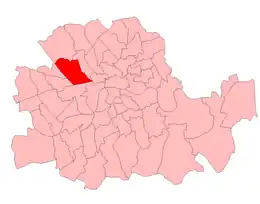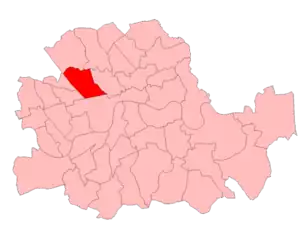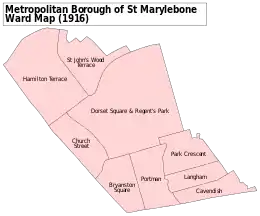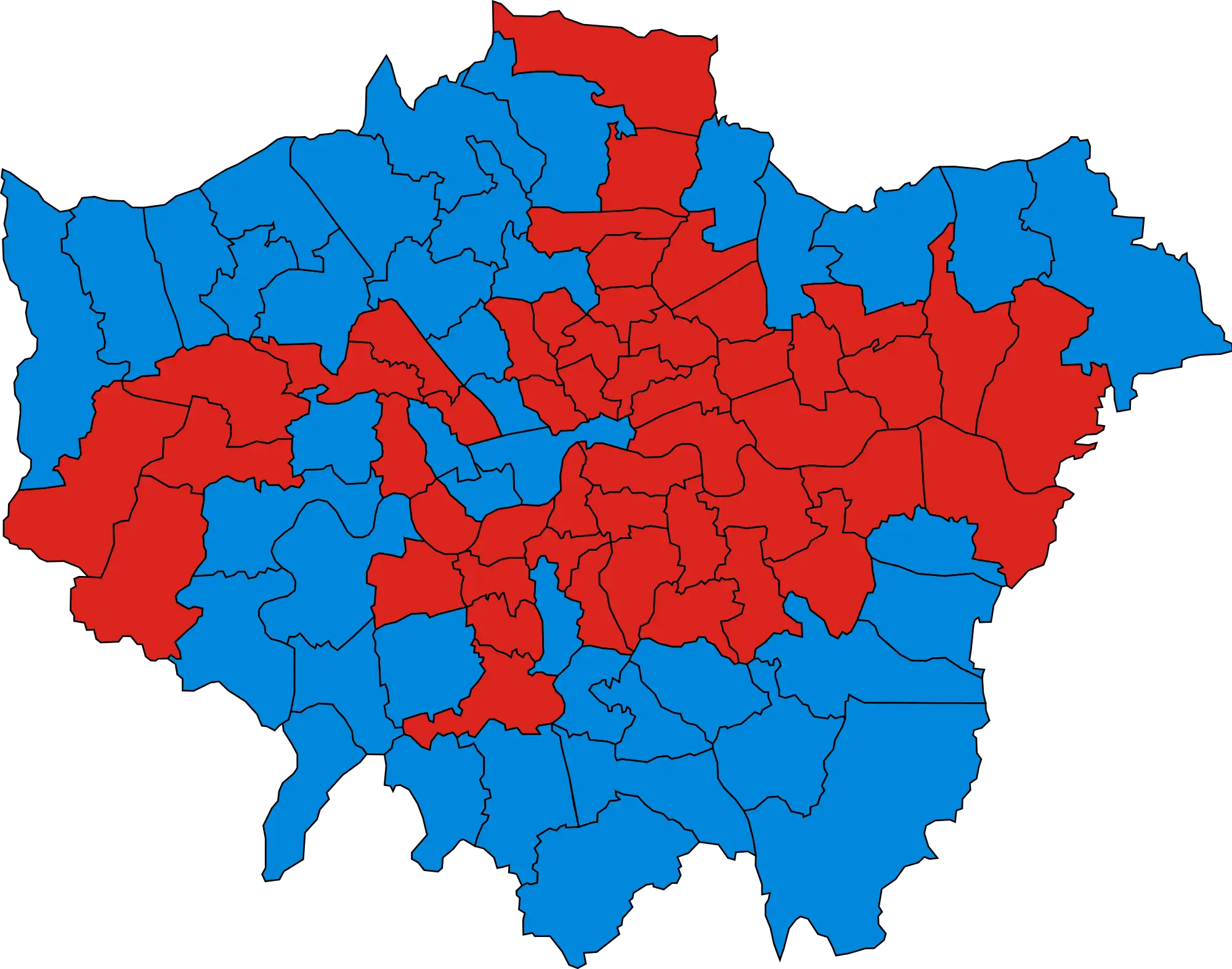| St Marylebone | |
|---|---|
| Former Borough constituency for the House of Commons | |
| 1918–1983 | |
| Seats | one |
| Created from | Marylebone East and Marylebone West |
| Replaced by | Westminster North and City of London and Westminster South[1] |
St Marylebone was a parliamentary constituency centred on the Marylebone district of Central London. It returned one Member of Parliament (MP) to the House of Commons of the Parliament of the United Kingdom.
It was created for the 1918 general election, and abolished for the 1983 general election.


Boundaries

Statutory description
1918–1950: The Metropolitan Borough of St Marylebone wards of Bryanston Square, Cavendish, Church Street, Dorset Square and Regent's Park, Hamilton Terrace, Langham, Park Crescent, Portman, and St John's Wood Terrace.
1950–1974: The Metropolitan Borough of St Marylebone wards of Bell Street, Bryanston Square, Cavendish Square, Church Street, Dorset Square, Hamilton Terrace, Lord's, Park Crescent, Portman Square, and St John's Wood Terrace.
1974–1983: The City of Westminster wards of Baker Street, Cavendish, Church Street, Lord's, and Regent's Park.
No substantive change
As shown by the maps, inset, there was no change in substance to the outer ward boundaries of this constituency during its lifetime.
Members of Parliament
| Year | Member | Party | |
|---|---|---|---|
| 1918 | Sir Samuel Scott | Unionist | |
| 1922 | Sir Douglas Hogg | Unionist | |
| 1928 | Sir Rennell Rodd | Unionist | |
| 1932 | Alec Cunningham-Reid | Conservative | |
| 1945 | Sir Wavell Wakefield | Conservative | |
| 1963 | Quintin Hogg | Conservative | |
| 1970 | Kenneth Baker | Conservative | |
| 1983 | constituency abolished | ||
Elections
Elections in the 1910s
| Party | Candidate | Votes | % | ±% | |
|---|---|---|---|---|---|
| C | Unionist | Samuel Scott | Unopposed | ||
| Unionist win (new seat) | |||||
| C indicates candidate endorsed by the coalition government. | |||||
Elections in the 1920s
| Party | Candidate | Votes | % | ±% | |
|---|---|---|---|---|---|
| Unionist | Douglas Hogg | Unopposed | |||
| Unionist hold | |||||
| Party | Candidate | Votes | % | ±% | |
|---|---|---|---|---|---|
| Unionist | Douglas Hogg | 16,763 | 66.6 | N/A | |
| Labour | James Jonas Dodd | 8,424 | 33.4 | New | |
| Majority | 8,339 | 33.2 | N/A | ||
| Turnout | 25,187 | 52.5 | N/A | ||
| Unionist hold | Swing | N/A | |||
| Party | Candidate | Votes | % | ±% | |
|---|---|---|---|---|---|
| Unionist | Douglas Hogg | 24,359 | 73.5 | +6.9 | |
| Labour | George Edward Elmer | 8,782 | 26.5 | -6.9 | |
| Majority | 8,339 | 47.0 | +13.8 | ||
| Turnout | 33,141 | 65.5 | +13.0 | ||
| Unionist hold | Swing | +6.9 | |||
| Party | Candidate | Votes | % | ±% | |
|---|---|---|---|---|---|
| Unionist | Rennell Rodd | 12,859 | 56.1 | -17.4 | |
| Labour | David Amyas Ross | 6,721 | 29.4 | +2.9 | |
| Liberal | Basil Murray | 3,318 | 14.5 | New | |
| Majority | 6,138 | 26.7 | -20.3 | ||
| Turnout | 22,898 | 43.1 | -22.4 | ||
| Unionist hold | Swing | -10.1 | |||
| Party | Candidate | Votes | % | ±% | |
|---|---|---|---|---|---|
| Unionist | Rennell Rodd | 26,247 | 61.4 | -12.1 | |
| Labour | David Amyas Ross | 10,960 | 25.7 | -0.8 | |
| Liberal | Cyril Picciotto | 5,520 | 12.9 | N/A | |
| Majority | 15,287 | 35.7 | -11.3 | ||
| Turnout | 42,727 | 57.3 | -8.2 | ||
| Unionist hold | Swing | -4.5 | |||
Elections in the 1930s
| Party | Candidate | Votes | % | ±% | |
|---|---|---|---|---|---|
| Conservative | Rennell Rodd | 39,976 | 86.7 | +25.3 | |
| Labour | Ernest Whitfield | 6,147 | 13.3 | -12.4 | |
| Majority | 33,829 | 73.4 | +36.7 | ||
| Turnout | 46,123 | 63.5 | +6.2 | ||
| Conservative hold | Swing | +18.3 | |||
| Party | Candidate | Votes | % | ±% | |
|---|---|---|---|---|---|
| Conservative | Alec Cunningham-Reid | 11,677 | 52.3 | -34.4 | |
| Ind. Conservative | Basil Blackett | 10,664 | 47.7 | New | |
| Majority | 1,013 | 4.6 | -68.8 | ||
| Turnout | 22,341 | 30.8 | -32.7 | ||
| Conservative hold | Swing | ||||
| Party | Candidate | Votes | % | ±% | |
|---|---|---|---|---|---|
| Conservative | Alec Cunningham-Reid | 31,183 | 79.6 | -7.1 | |
| Labour | Elizabeth Jacobs | 8,008 | 20.4 | New | |
| Majority | 23,175 | 59.2 | -14.2 | ||
| Turnout | 39,271 | 57.9 | -5.6 | ||
| Conservative hold | Swing | N/A | |||
Elections in the 1940s
General Election 1939–40
Another General Election was required to take place before the end of 1940. The political parties had been making preparations for an election to take place and by the Autumn of 1939, the following candidates had been selected;
- Conservative: Alec Cunningham-Reid
- Labour: Elizabeth Jacobs[3]
| Party | Candidate | Votes | % | ±% | |
|---|---|---|---|---|---|
| Conservative | Wavell Wakefield | 15,891 | 47.9 | -31.7 | |
| Labour | Elizabeth Jacobs | 10,740 | 32.4 | +12.0 | |
| Ind. Conservative | Alec Cunningham-Reid | 3,824 | 11.5 | New | |
| Liberal | Thomas Lodge | 2,711 | 8.2 | New | |
| Majority | 5,151 | 15.5 | -43.7 | ||
| Turnout | 33,166 | 68.3 | +10.4 | ||
| Conservative hold | Swing | ||||
Elections in the 1950s
| Party | Candidate | Votes | % | ±% | |
|---|---|---|---|---|---|
| Conservative | Wavell Wakefield | 26,310 | 60.7 | +12.8 | |
| Labour | John Silkin | 12,890 | 29.7 | -2.7 | |
| Liberal | Bjorn Guy | 4,149 | 9.6 | +1.4 | |
| Majority | 13,420 | 31.0 | N/A | ||
| Turnout | 43,349 | 75.2 | +6.9 | ||
| Conservative hold | Swing | N/A | |||
| Party | Candidate | Votes | % | ±% | |
|---|---|---|---|---|---|
| Conservative | Wavell Wakefield | 28,783 | 67.3 | +6.6 | |
| Labour | William Balfour | 13,964 | 32.7 | +3.0 | |
| Majority | 14,819 | 34.6 | +3.6 | ||
| Turnout | 42,747 | 70.3 | -4.9 | ||
| Conservative hold | Swing | +1.8 | |||
| Party | Candidate | Votes | % | ±% | |
|---|---|---|---|---|---|
| Conservative | Wavell Wakefield | 26,302 | 70.7 | +3.4 | |
| Labour | Ivan Michael Yates | 10,903 | 29.3 | -3.4 | |
| Majority | 15,399 | 41.4 | +6.8 | ||
| Turnout | 37,205 | 64.5 | -5.8 | ||
| Conservative hold | Swing | +3.4 | |||
| Party | Candidate | Votes | % | ±% | |
|---|---|---|---|---|---|
| Conservative | Wavell Wakefield | 23,278 | 64.5 | -6.2 | |
| Labour | Benjamin Hooberman | 8,507 | 23.6 | -5.7 | |
| Liberal | Edwin Michael Wheeler | 4,304 | 11.9 | New | |
| Majority | 14,771 | 40.9 | -0.5 | ||
| Turnout | 36,089 | 65.5 | +1.0 | ||
| Conservative hold | Swing | -0.2 | |||
Elections in the 1960s
| Party | Candidate | Votes | % | ±% | |
|---|---|---|---|---|---|
| Conservative | Quintin Hogg | 12,495 | 54.97 | -9.53 | |
| Labour | Peter William Plouviez | 7,219 | 31.76 | +8.19 | |
| Liberal | Edwin Michael Wheeler | 3,016 | 13.27 | +1.34 | |
| Majority | 5,276 | 23.21 | -17.7 | ||
| Turnout | 22,730 | ||||
| Conservative hold | Swing | ||||
| Party | Candidate | Votes | % | ±% | |
|---|---|---|---|---|---|
| Conservative | Quintin Hogg | 18,117 | 56.23 | ||
| Labour | Peter William Plouviez | 9,324 | 28.94 | ||
| Liberal | Arthur William R. Capel | 4,776 | 14.82 | ||
| Majority | 8,793 | 27.29 | |||
| Turnout | 32,217 | 64.43 | |||
| Conservative hold | Swing | ||||
| Party | Candidate | Votes | % | ±% | |
|---|---|---|---|---|---|
| Conservative | Quintin Hogg | 17,443 | 56.67 | ||
| Labour | Cyril Cooper | 9,382 | 30.48 | ||
| Liberal | Arthur William R. Capel | 3,258 | 10.58 | ||
| Anti Common Market | Christopher Newman Frere-Smith | 445 | 1.45 | New | |
| Independent | Evan Jeremy Miller | 252 | 0.82 | New | |
| Majority | 8,061 | 26.19 | |||
| Turnout | 30,780 | 65.08 | |||
| Conservative hold | Swing | ||||
Elections in the 1970s
| Party | Candidate | Votes | % | ±% | |
|---|---|---|---|---|---|
| Conservative | Quintin Hogg | 17,639 | 62.1 | +4.4 | |
| Labour | Keith W. Morrell | 8,325 | 29.3 | -1.2 | |
| Liberal | Michael B.J. Vann | 2,443 | 8.6 | -2.0 | |
| Majority | 9,314 | 32.8 | +6.6 | ||
| Turnout | 28,407 | 59.6 | -5.5 | ||
| Conservative hold | Swing | ||||
| Party | Candidate | Votes | % | ±% | |
|---|---|---|---|---|---|
| Conservative | Kenneth Baker | 10,684 | 63.49 | +1.40 | |
| Labour | Keith W. Morrell | 4,542 | 26.99 | -2.32 | |
| Liberal | Michael B.J. Vann | 1,038 | 6.19 | -2.41 | |
| National Front | Malcolm Skeggs | 401 | 2.38 | New | |
| Fourth World Group | John Papworth | 163 | 0.97 | New | |
| Majority | 6,142 | 36.50 | |||
| Turnout | 16,828 | ||||
| Conservative hold | Swing | ||||
| Party | Candidate | Votes | % | ±% | |
|---|---|---|---|---|---|
| Conservative | Kenneth Baker | 15,683 | 54.6 | -7.5 | |
| Labour | J Merriton | 6,996 | 24.3 | -5.0 | |
| Liberal | Bernard Silver | 5,599 | 19.5 | +10.9 | |
| Independent Powellite | W Davies | 470 | 1.6 | New | |
| Majority | 8,717 | 30.3 | -2.3 | ||
| Turnout | 28,748 | 66.1 | +6.5 | ||
| Conservative hold | Swing | ||||
| Party | Candidate | Votes | % | ±% | |
|---|---|---|---|---|---|
| Conservative | Kenneth Baker | 13,660 | 54.9 | +0.3 | |
| Labour | Patricia Moberly | 7,157 | 28.8 | +4.5 | |
| Liberal | Bernard Silver | 4,067 | 16.3 | -3.2 | |
| Majority | 6,503 | 26.1 | -4.2 | ||
| Turnout | 24,884 | 57.1 | -9.0 | ||
| Conservative hold | Swing | -2.1 | |||
| Party | Candidate | Votes | % | ±% | |
|---|---|---|---|---|---|
| Conservative | Kenneth Baker | 14,899 | 59.9 | +5.0 | |
| Labour | Joseph Hegarty | 6,586 | 26.5 | -2.3 | |
| Liberal | Edward Mann | 2,459 | 9.9 | -6.4 | |
| Ecology | Jonathon Porritt | 691 | 2.8 | New | |
| National Front | Charles Elrick[7] | 239 | 1.0 | New | |
| Majority | 8,313 | 33.4 | +7.3 | ||
| Turnout | 24,874 | ||||
| Conservative hold | Swing | ||||
References
- ↑ "'St Marylebone', Feb 1974 - May 1983". ElectionWeb Project. Cognitive Computing Limited. Retrieved 21 March 2016.
- 1 2 3 4 5 6 7 8 British Parliamentary Election Results 1918-1949, FWS Craig
- ↑ Report of the Annual Conference of the Labour Party, 1939
- 1 2 3 4 5 6 7 British Parliamentary Election Results 1950-1973, FWS Craig
- 1 2 3 4 5 6 7 The Times House of Commons, 1950-70
- ↑ "1963 By Election Results". Archived from the original on 25 February 2012. Retrieved 17 August 2015.
- ↑ Election Expenses. Parliament of the United Kingdom. 1980. p. 23. ISBN 0102374805.
- Leigh Rayment's Historical List of MPs – Constituencies beginning with "S" (part 1)
- Craig, F. W. S. (1983) [1969]. British parliamentary election results 1918–1949 (3rd ed.). Chichester: Parliamentary Research Services. p. 43. ISBN 0-900178-06-X.
